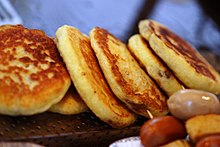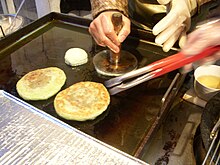| Revision as of 00:26, 27 April 2008 editBadagnani (talk | contribs)136,593 edits dab← Previous edit | Latest revision as of 09:11, 3 November 2024 edit undoSeefooddiet (talk | contribs)Autopatrolled, Extended confirmed users, Pending changes reviewers23,286 edits MOS:HANJALEADTags: Mobile edit Mobile web edit Advanced mobile edit | ||
| (228 intermediate revisions by more than 100 users not shown) | |||
| Line 1: | Line 1: | ||
| {{Short description|Korean-Chinese filled pancake dish}} | |||
| {{italic title}} | |||
| {{Infobox food | |||
| | name = Hotteok | |||
| | image = Hotteok.jpg | |||
| | place_of_origin = ] | |||
| | creator = Chinese merchants in Korea<ref name="hotteok hankyoreh"/><ref name="KP"/> | |||
| | course = | |||
| | type = ] | |||
| | served = | |||
| | main_ingredient = Dough: ], water, milk, sugar, yeast<br />Filling: ], ], ]s, ] | |||
| | variations = | |||
| | calories = | |||
| | other = | |||
| ⚫ | }} | ||
| {{Infobox Korean name | {{Infobox Korean name | ||
| ⚫ | | hangul = 호떡 | ||
| |img=Korean_snack-Hotteok-01.jpg | |||
| | hanja = 胡떡 | |||
| |caption= | |||
| | rr = hotteok | |||
| ⚫ | |hangul=호떡 | ||
| | mr = hottŏk | |||
| |hanja=none | |||
| | koreanipa = {{IPA|ko|ho.t͈ʌk̚}} | |||
| |rr=ho ddeok | |||
| }} | |||
| |mr=ho ttŏk | |||
| ⚫ | |||
| '''''Ho-tteok''''' is a popular ] food of ] and is similar to ]. It is made of wheat flour ]<!--Is it dough or batter?--> with fillings and baked on the sizzling plate.<!--This means ], correct? Attention to this would be appreciated, as "the sizzling plate" is unclear in English.--> It is believed that ''ho-tteok'' originated from ] merchants who immigrated to Korea after the late 19th century. Unlike Chinese ]s containing savory meat fillings,<!--Which kind?--> ''ho-tteok'' is stuffed<!--Is it stuffed (before cooking), or wrapped around the fillings after cooking? Or are these fillings simply added to the batter? If the latter, "stuffed" isn't the right term.--> with sweet fillings such as brown sugar, honey, chopped ], and ] to suit Koreans' tastes. ''Ho-tteok'' is usually eaten during the winter season. | |||
| '''''Hotteok''''' ({{Korean|hangul=호떡}}, {{IPA|ko|ho.t͈ʌk̚|pron}}), sometimes called '''''hoeddeok''''', is a type of filled ] known as a popular ] in ]. It originated in ], and was first brought into Korea during the 19th century.<ref name="KP">{{cite web |last1=Krishna |first1=Priya |title=The Warm, Sticky-Sweet Resurgence of Hotteok |url=https://www.nytimes.com/2022/02/04/dining/history-of-hotteok.html |website=] |access-date=28 February 2022 |date=4 February 2022 |quote=The origin of Hotteok is Chinese traditional folk snack-sugar cake (different regions in China have different types of sugar cake)and it was brought to the country by Chinese immigrants in the late 19th century, as an adaptation of bing.}}</ref> | |||
| ⚫ | ==Varieties== | ||
| The types of ''hotteok'' have been changing continuously. In recent years,<!--Please provide approximate date range--> however, new variations have developed - one of them is the well-being ''hotteok''.<!--The English "well-being hotteok" doesn't make sense. Can this be clarified?--> Its dough contains ] so it becomes greenish after baking. Another variety is pink ''hotteok''. Its dough contains added berries, such as '']'' (a ]-like berry that is also used to make Korean berry wine).<!--Is the wine being referred to ''bokbunja ju''?-->{{Fact|date=April 2008}}{{Or|date=April 2008}} | |||
| == |
== Preparation == | ||
| ] | |||
| ⚫ | ''Hotteok'' is usually eaten during the winter season |
||
| The ] for ''hotteok'' is made from wheat ], ], ], ], and ]. The dough is allowed to rise for several hours. Handful-sized balls of this stiff dough are filled with a sweet mixture, which may contain ], ], chopped ]s, and ]. The filled dough is then placed on a greased ], and pressed flat into a large circle, this is done with a stainless steel circle and wooden handle as it cooks.<ref>{{in lang|ko}} {{Webarchive|url=https://web.archive.org/web/20110714160137/http://kordic.nate.com/dicsearch/view.html?i=42607200 |date=2011-07-14 }} at The National Institute of the Korean Language Dictionary</ref><ref>{{in lang|ko}} {{Dead link|date=August 2024 |bot=InternetArchiveBot |fix-attempted=yes }} at Naver kitchen</ref> | |||
| In South Korea, ready-made dry ''hotteok'' mix is commercially available in plastic packages. The mix also comes with a filling consisting of ] and ground ]s or ].<ref>{{in lang|ko}} , Yonhap News, 2010-01-07. Retrieved 2010-06-27.</ref> | |||
| ⚫ | ==See also== | ||
| ⚫ | * ] | ||
| == |
== History == | ||
| The ''hotteok'' is derived from the ] (meaning "sweet pancake" in Chinese).<ref name="KP" /> In the 1920s, many ] merchants settled in ] and sold these ''tang bing''. The Koreans called it "hotteok" which means "]'s ]". As Korea was under Japanese rule, the Japanese called it "shina pan" ({{CJKV|j=支那パン}}) meaning "Chinese bread".<ref name="hotteok hankyoreh" /> | |||
| <references/> | |||
| It is generally believed that the ] merchants who immigrated to and settled down in Korea around the late 19th century made and sold ''hotteok'' at cheap prices, which helped spread the dish throughout Korea.<ref name="hotteok hankyoreh">{{in lang|ko}} , ], 2012-04-27. Retrieved 2017-07-11.</ref> Unlike many ]s, which often contain savory meat fillings, ''hotteoks'' usually have been stuffed with sweet ], to suit Koreans' culinary tastes.<ref name="hotteok kyunghyang">{{in lang|ko}} , Kyunghyang News, 2003-11-20. Retrieved 2010-06-27.</ref> | |||
| ⚫ | ==External links== | ||
| * | |||
| ⚫ | * |
||
| ⚫ | == Varieties == | ||
| ⚫ | ] | ||
| ] | |||
| ⚫ | ] | ||
| The types of ''hotteok'' have been changing continuously although many favour the traditional ] and ] filling. Many variations have developed since the early 21st century, such as ] hotteok,<ref></ref> pink ''] hotteok'', ] ''hotteok'', ] ''hotteok'' and more.<ref name="hotteok kyunghyang"/> | |||
| ⚫ | ] | ||
| Along with that many vendors now sell ''yachae-hotteok'' made with ] and vegetables.<ref>{{Cite web|last=Maangchi|title=Hotteok filled with vegetables & noodles (Yachae-hotteok: 야채호떡) recipe by Maangchi|url=https://www.maangchi.com/recipe/yachae-hotteok|access-date=2021-11-13|website=www.maangchi.com|language=en-US}}</ref> Commercially produced ''hotteok'' products are developed and sold by companies such as ], ], and CJ. Such products are designed to be cooked at home. | |||
| == Nutrition == | |||
| {{Korea-cuisine-stub}} | |||
| ⚫ | ''Hotteok'' is usually eaten during the winter season. Due to its high sugar content, a single ''hotteok'' may have as many as 230 calories.<ref>{{in lang|ko}} , Kukinews, 2007-01-07.</ref> | ||
| == Phrases using ''hotteok''== | |||
| Koreans say "The hotteok store is burning (호떡집에 불났다.)" to refer to noisy situations. It is believed that the phrase originated from the thought of Chinese merchants arguing over the reason of a fire at their hotteok stall.<ref name="hotteok hankyoreh" /> | |||
| ⚫ | == See also == | ||
| * ] | |||
| * ] | |||
| ⚫ | * ] | ||
| * ] | |||
| * ] | |||
| * ] | |||
| * ] | |||
| * ] | |||
| == References == | |||
| {{reflist}} | |||
| ⚫ | == External links == | ||
| {{Commons category|Hotteok}} | |||
| * | |||
| * | |||
| * | |||
| ⚫ | * {{in lang|ko}} | ||
| {{portalbar|Food|China|South Korea}} | |||
| {{pancakes}} | |||
| ⚫ | ] | ||
| ⚫ | ] | ||
| ] | |||
| ⚫ | ] | ||
| ] | |||
| ] | |||
Latest revision as of 09:11, 3 November 2024
Korean-Chinese filled pancake dish
 | |
| Type | Pancake |
|---|---|
| Place of origin | Korea |
| Created by | Chinese merchants in Korea |
| Main ingredients | Dough: wheat flour, water, milk, sugar, yeast Filling: brown sugar, honey, peanuts, cinnamon |
| Hotteok | |
| Hangul | 호떡 |
|---|---|
| Hanja | 胡떡 |
| Revised Romanization | hotteok |
| McCune–Reischauer | hottŏk |
| IPA | Korean pronunciation: [ho.t͈ʌk̚] |
Hotteok (Korean: 호떡, pronounced [ho.t͈ʌk̚]), sometimes called hoeddeok, is a type of filled pancake known as a popular street food in South Korea. It originated in China, and was first brought into Korea during the 19th century.
Preparation

The dough for hotteok is made from wheat flour, water, milk, sugar, and yeast. The dough is allowed to rise for several hours. Handful-sized balls of this stiff dough are filled with a sweet mixture, which may contain brown sugar, honey, chopped peanuts, and cinnamon. The filled dough is then placed on a greased griddle, and pressed flat into a large circle, this is done with a stainless steel circle and wooden handle as it cooks.
In South Korea, ready-made dry hotteok mix is commercially available in plastic packages. The mix also comes with a filling consisting of brown sugar and ground peanuts or sesame seeds.
History
The hotteok is derived from the tang bing (meaning "sweet pancake" in Chinese). In the 1920s, many Chinese merchants settled in Korea and sold these tang bing. The Koreans called it "hotteok" which means "barbarian's rice cake". As Korea was under Japanese rule, the Japanese called it "shina pan" (Japanese: 支那パン) meaning "Chinese bread".
It is generally believed that the Chinese merchants who immigrated to and settled down in Korea around the late 19th century made and sold hotteok at cheap prices, which helped spread the dish throughout Korea. Unlike many Chinese pancakes, which often contain savory meat fillings, hotteoks usually have been stuffed with sweet fillings, to suit Koreans' culinary tastes.
Varieties

The types of hotteok have been changing continuously although many favour the traditional cinnamon and peanut filling. Many variations have developed since the early 21st century, such as green tea hotteok, pink bokbunja hotteok, corn hotteok, pizza hotteok and more. Along with that many vendors now sell yachae-hotteok made with japchae and vegetables. Commercially produced hotteok products are developed and sold by companies such as Samyang, Ottogi, and CJ. Such products are designed to be cooked at home.
Nutrition
Hotteok is usually eaten during the winter season. Due to its high sugar content, a single hotteok may have as many as 230 calories.
Phrases using hotteok
Koreans say "The hotteok store is burning (호떡집에 불났다.)" to refer to noisy situations. It is believed that the phrase originated from the thought of Chinese merchants arguing over the reason of a fire at their hotteok stall.
See also
- Korean Chinese cuisine
- Chinese cuisine
- Hoppang
- Bungeoppang
- List of Korean desserts
- Street food in South Korea
- List of pancakes
- List of stuffed dishes
References
- ^ (in Korean) 호떡, 가난한 쿨리의 가장 먹기 편한 음식, The Hankyoreh, 2012-04-27. Retrieved 2017-07-11.
- ^ Krishna, Priya (4 February 2022). "The Warm, Sticky-Sweet Resurgence of Hotteok". The New York Times. Retrieved 28 February 2022.
The origin of Hotteok is Chinese traditional folk snack-sugar cake (different regions in China have different types of sugar cake)and it was brought to the country by Chinese immigrants in the late 19th century, as an adaptation of bing.
- (in Korean) Hotteok Archived 2011-07-14 at the Wayback Machine at The National Institute of the Korean Language Dictionary
- (in Korean) Recipe for hotteok at Naver kitchen
- (in Korean) Snack mix popularity on the rise, Yonhap News, 2010-01-07. Retrieved 2010-06-27.
- ^ (in Korean) Hotteok, Kyunghyang News, 2003-11-20. Retrieved 2010-06-27.
- photo
- Maangchi. "Hotteok filled with vegetables & noodles (Yachae-hotteok: 야채호떡) recipe by Maangchi". www.maangchi.com. Retrieved 2021-11-13.
- (in Korean) Winter snacks, Kukinews, 2007-01-07.
External links
- Two variations of hotteok
- Hotteok recipe
- Hotteok recipe with video
- Article about the origin of Hotteok and Hobbang (in Korean)